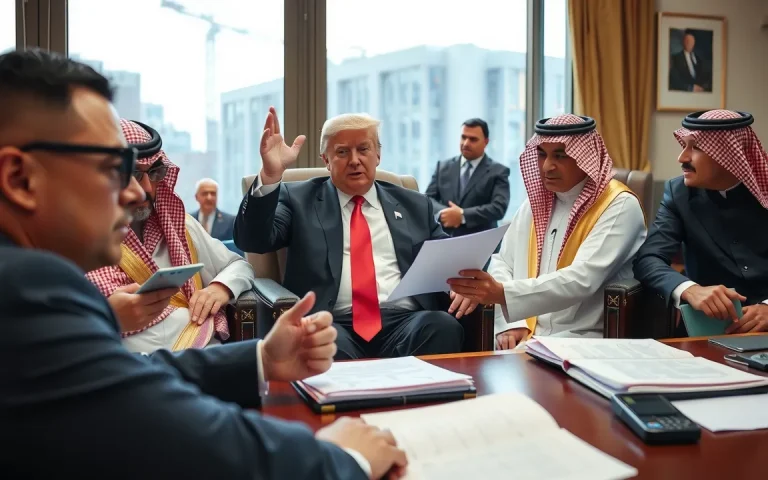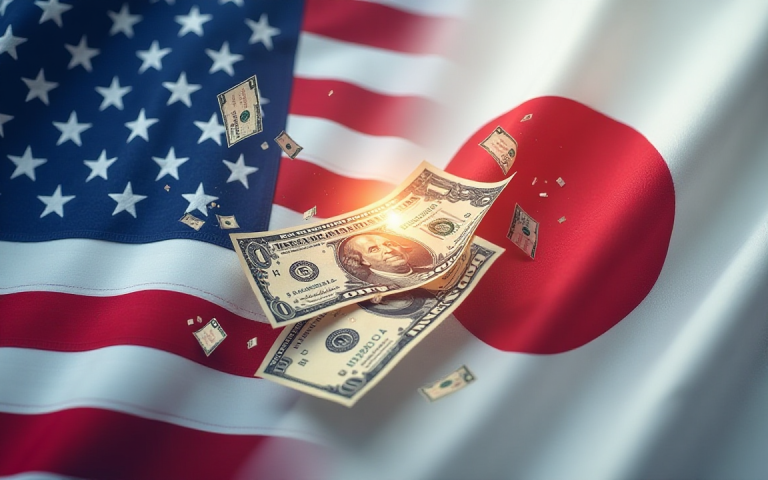President Donald Trump’s affinity for grand economic agreements is well-documented, rivaled perhaps only by his preference for low gasoline prices for American consumers.
His current diplomatic tour of the Gulf states, however, appears to be steering these two objectives onto a collision course, particularly concerning a much-vaunted investment pledge from Saudi Arabia.
The Trump administration has enthusiastically promoted a Saudi investment initiative, with figures cited ranging from a substantial $600 billion to an eye-watering $1 trillion.
To put such numbers in perspective, a $1 trillion commitment would equate to the entirety of Saudi Arabia’s sovereign wealth fund or its annual Gross Domestic Product.
For the Kingdom to sustain such an ambitious level of long-term investment in the United States, economists suggest it would almost certainly necessitate a significant increase in currently subdued oil prices—a development highly likely to draw President Trump’s ire.
Fueling ambition: the oil price imperative for Saudi pledges
The feasibility of these colossal figures is intrinsically linked to the price of crude.
“The number is impressive, but its significance will ultimately depend on the depth, timeline, and the price of oil,” John Sfakianakis, chief economist and head of research at the Gulf Research Center in Riyadh, told Fortune.
Unless oil revenues rise, financing such commitments will strain public finances unless managed prudently.
Currently, oil constitutes approximately 60% of Saudi Arabia’s revenue, according to Gulf News.
This heavy reliance underscores the challenge.
“These pledges will of course have to face up to reality as indeed they are large,” Maya Senussi, lead economist at Oxford Economics, explained to Fortune in an email.
In our view, the headwinds to public finances from lower energy prices and focus on domestic Vision 2030 priorities mean the announced pledges will likely only partly materialise within the four-year timeframe.
The Kingdom’s ambitious Vision 2030 program, aimed at diversifying its economy through massive public-works projects, carries its own hefty price tag, estimated as high as $1.5 trillion.
To merely break even on its spending, Saudi Arabia requires an oil price of at least $96 a barrel, as estimated by Bloomberg, with other analyses placing the figure even north of $100.
This starkly contrasts with the current trading price of Brent crude, the international benchmark, which hovers around $65 a barrel.
The presidential push for pump relief: a brewing conflict?
That $65 figure is significantly lower than the $79 per barrel seen in January when President Trump assumed office—a price he openly deemed too high.
“I’m also going to ask Saudi Arabia and OPEC to bring down the cost of oil,” he declared at the World Economic Forum on January 23.
“You got to bring it down, which, frankly, I’m surprised they didn’t do before the election,” Trump added.
That didn’t show a lot of love.
It appears that “love,” or at least a strategic alignment, eventually materialized. OPEC recently announced production increases for May and June, a move that subsequently pushed oil prices lower.
Reuters columnist Ron Bousso characterized the Saudis’ action as an “unspoken gift to Trump.”
Indeed, Clayton Seigle, a senior fellow at the Center for Strategic and International Studies, wrote on Wednesday that lower gasoline prices mean “Trump has already scored his big Saudi win”.
The longevity of these lower prices, however, remains an open question.
Beyond the billions: economists question scale of Saudi commitment
The headline figure of $600 billion, let alone $1 trillion, has been met with considerable skepticism from many economic observers, who find the scale unusually large.
A fact sheet distributed by the White House detailed investments totaling a more modest $282 billion, which includes $142 billion in promised US arms sales.
Paul Donovan, chief economist of UBS Global Wealth Management, commented this week that the $600 billion plan possesses “a fanfare of spin, which does not necessarily change anything in reality.
The announcement does not require economic forecasts to change.”
Regarding the $1 trillion spending figure reportedly sought by Trump, Ziad Daoud, Bloomberg’s chief emerging markets economist, described it to The New York Times as “far-fetched.”
Even the $600 billion figure represents roughly 60% of Saudi Arabia’s GDP and about 40% of its current foreign assets, according to Tim Callen, a visiting fellow at the Arab Gulf States Institute and a former IMF official.
Callen wrote earlier this year that meeting such a target would necessitate the Kingdom quintupling the portion of foreign imports it sources from the US over the next four years.
While “it seems likely that Saudi investments in the United States will grow,” he conceded, “the scale of the commitment looks too large.”
Vision 2030: balancing domestic dreams with foreign Deals
Further complicating these substantial commitments is the aforementioned Vision 2030.
The immense domestic spending required by this program, estimated at $1.3 trillion, has already pushed the Kingdom into deficit spending.
Compounded by falling oil prices, Saudi Arabia’s deficit could potentially double by the end of this year to $70 billion, Farouk Soussa of Goldman Sachs told CNBC.
While Saudi Arabia can absorb some short-term deficit spending, Soussa noted, it will likely seek to close this gap through measures such as project cutbacks, asset sales, or tax increases.
The politics of pledges
President Trump has previously claimed Saudi Arabia purchased $450 billion of US exports during his first term.
However, Callen, from the Arab Gulf States Institute, asserts this figure was not “anywhere near” reality.
The practice of announcing grandiose public projects that later fall short of expectations is not unique.
Politicians often leverage such declarations to showcase their business-friendly credentials, leading to a veritable cottage industry dedicated to debunking these claims.
“Let’s be honest, announcements are always at the high end. I don’t think the actual effect is as big as the headline. But the sign is positive,” Simon Johnson, a Nobel prize-winning MIT economist, told Fortune.
Johnson had previously suggested that CEOs might announce development deals in swing states to curry favor with Trump, even if those promises ultimately proved to be “vaporware.”
During Trump’s first term, Johnson observed, “there were a lot of promises that didn’t come to fruition.”
He added, “But that is kind of the nature of the business: If you’re making big investments, they don’t happen overnight.”
The true scope and impact of Saudi Arabia’s current pledges will, therefore, likely unfold over a considerable period, contingent on numerous economic and geopolitical factors, chief among them the volatile price of oil.
The post Saudi Arabia’s $600B US bet: can high oil prices and Trump’s low gas wishes coexist? appeared first on Invezz










